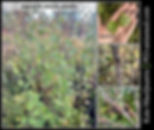Bog Birch
- katemacquarrie22
- Oct 29
- 2 min read
This fall, we’ve been exploring some of PEI’s least-common trees, including Balsam Poplar, Ironwood, and Jack Pine. Today it’s one many people haven’t even heard of: Bog Birch (Betula pumila).

We often think of Birch as among the majestic trees of PEI’s early forests. Nineteenth century writers told of Yellow Birch (Betula alleghaniensis) three to four feet in diameter, and it was said that Mi’kmaq people were able to make a six-person canoe from the bark of a single White Birch (B. papyrifera). Bog Birch doesn’t share the impressive stature of these relatives: it’s a multi-stemmed shrub that rarely grows taller than 10 feet (main photo).
I think small can be beautiful, and I’m always happy to encounter Bog Birch. Unlike Yellow and White Birch that grow in shady, mature forests, or White and Grey Birch that are found in younger forests and open areas, Bog Birch prefers peatlands and swampy forests. It’s legitimately less common than our other Birches, but I suspect it’s a bit under-reported on the Island because people tend not to hang out in those wet habitats.
In addition to its size, Bog Birch is easily distinguished by oval, toothed leaves that are unlike any of our other Birches. Grey Birch (aka Wire Birch, B. populifolia) sometimes shares the same habitats, but its pointed leaves are distinctive (top right photo).
Even without leaves, Bog Birch isn’t too hard to identify. Twigs are densely hairy in their first year, becoming smooth by year two. Older bark is smooth and reddish-brown with scatted dots called ‘lenticels’ that allow the flow of oxygen and carbon dioxide through the bark (middle right photo). Lenticels aren’t unique to Bog Birch, but their size, shape, and distribution can be helpful clues in tree identification.
Like other Birches, Bog Birch produces finger-like flowers called ‘catkins’, with male and female flowers on the same tree. Male catkins disappear once pollination is done in spring, but Bog Birch’s female catkins can be found on the plant well into summer, fall, and early winter (bottom right photo).
I admire Bog Birch’s tenacity and adaptability. In addition to being one of the few trees that can handle PEI’s acidic, nutrient-poor bogs and low-oxygen, swampy soils, it also grows in dune habitats, and – elsewhere in its range – on alkaline soils and limestone barrens. Wet, dry, sandy, peaty, acidic, alkaline: Bog Birch covers it all (likely with help from mycorrhizal fungi).
I suspect Bog Birch was once more common on the Island than it is today; three centuries of human land use have converted some of its habitat to other uses. Even so, Bog Birch persists as a beautiful, native part of PEI Untamed!
